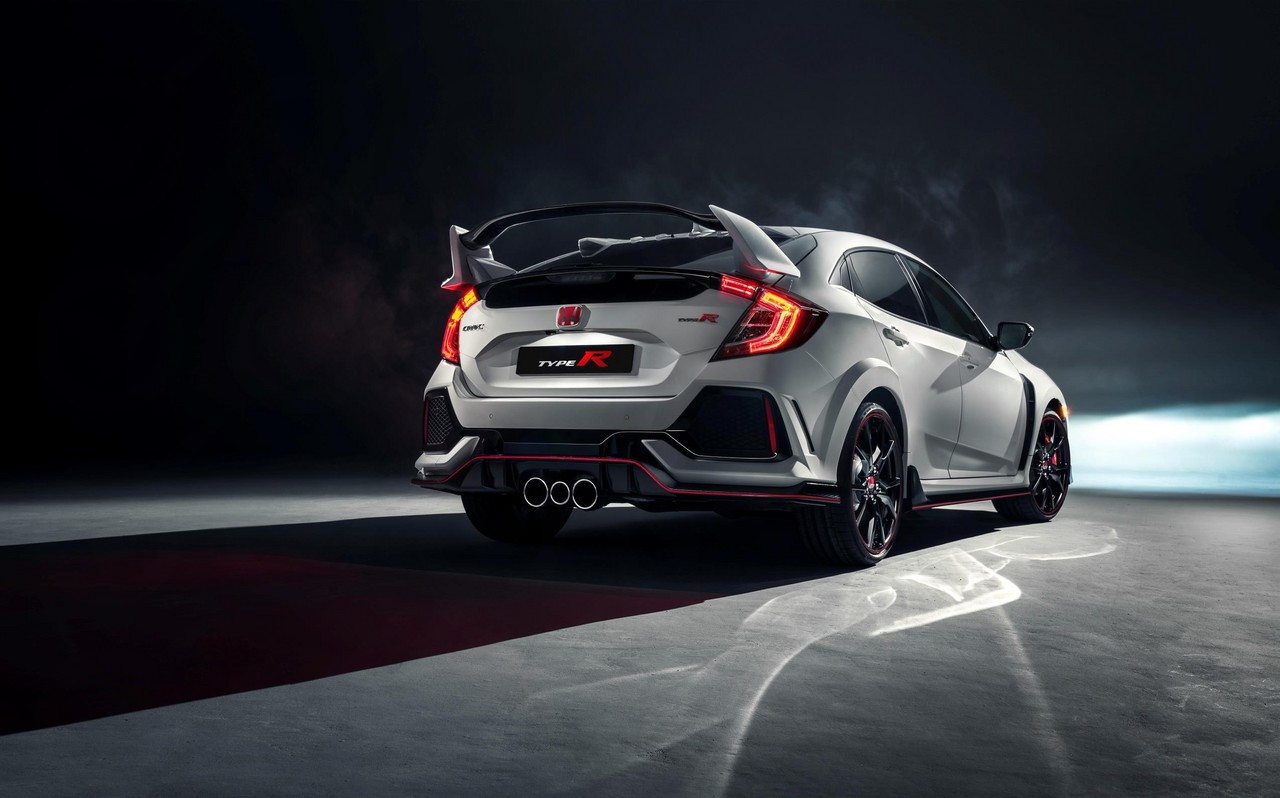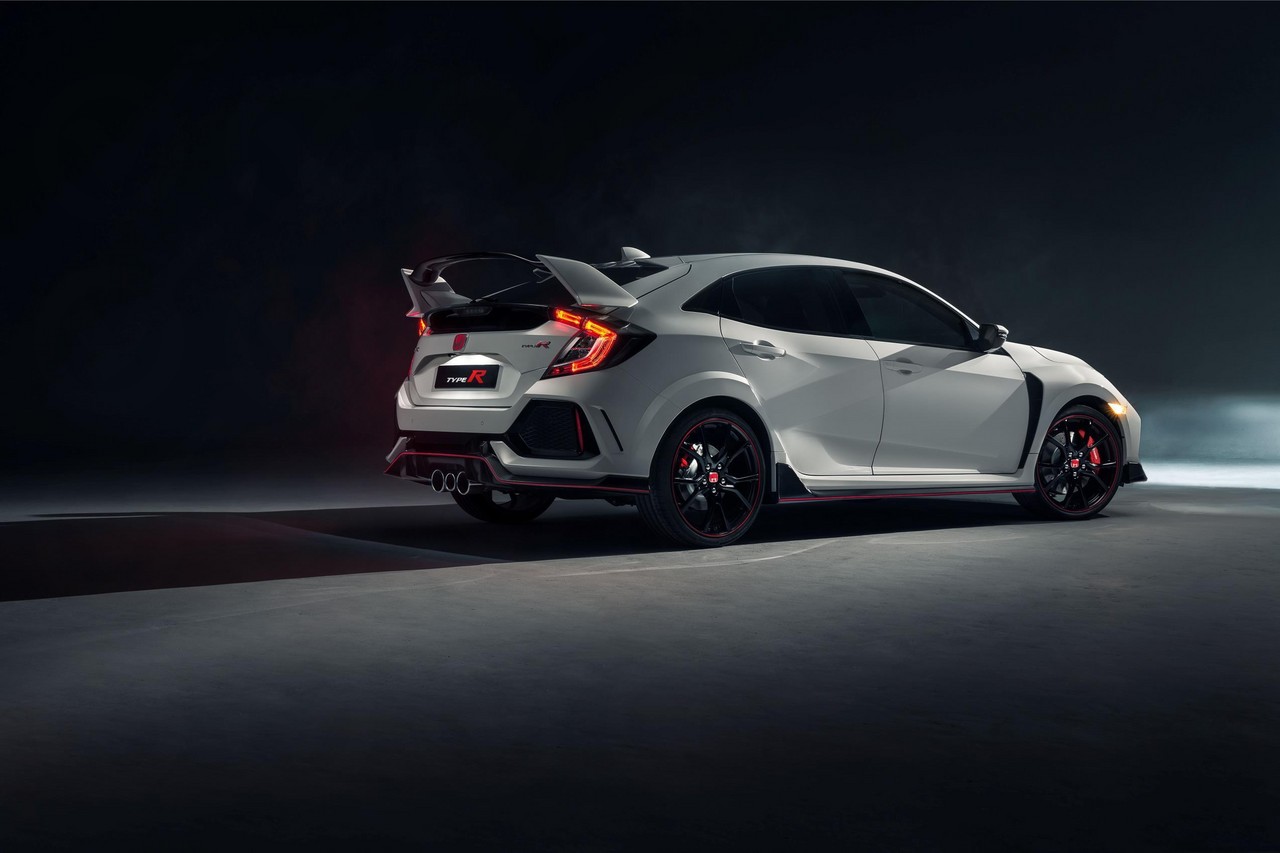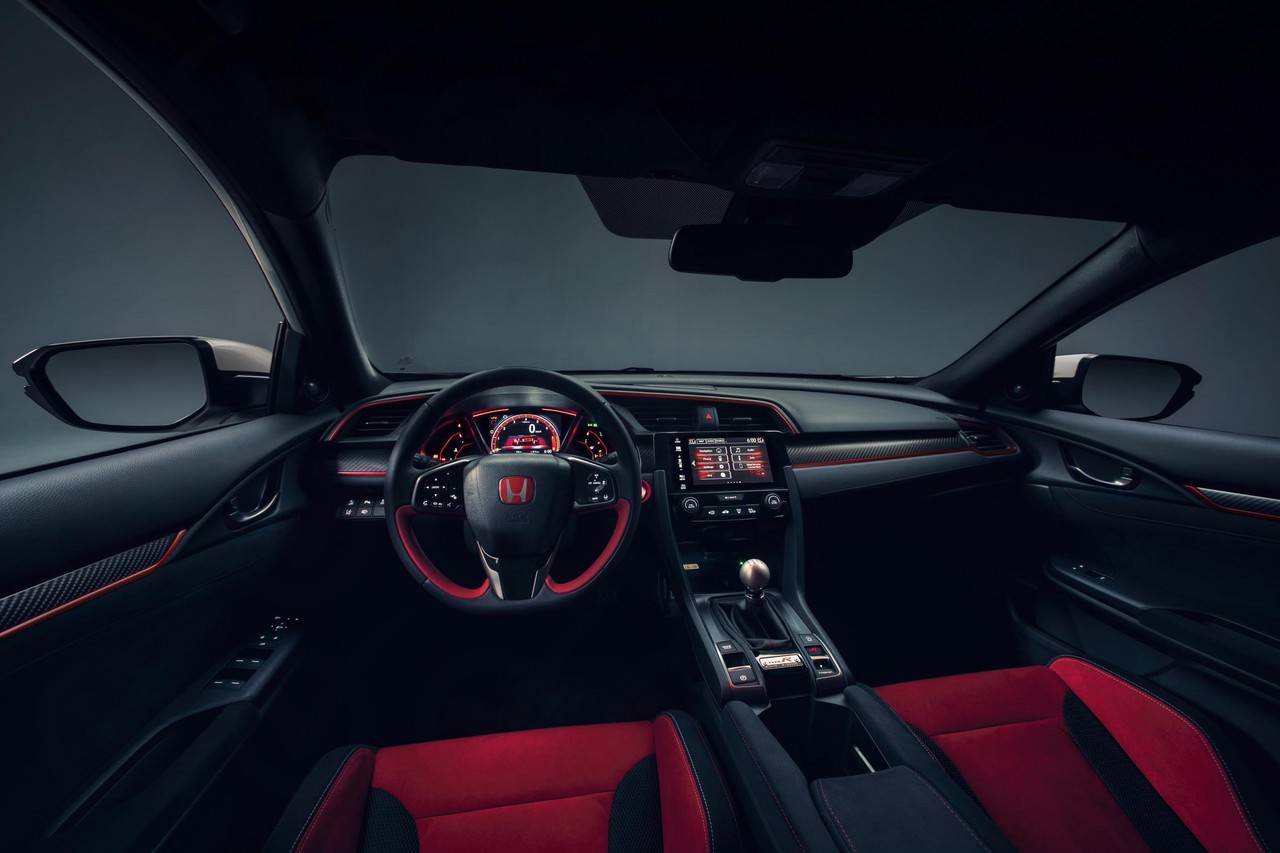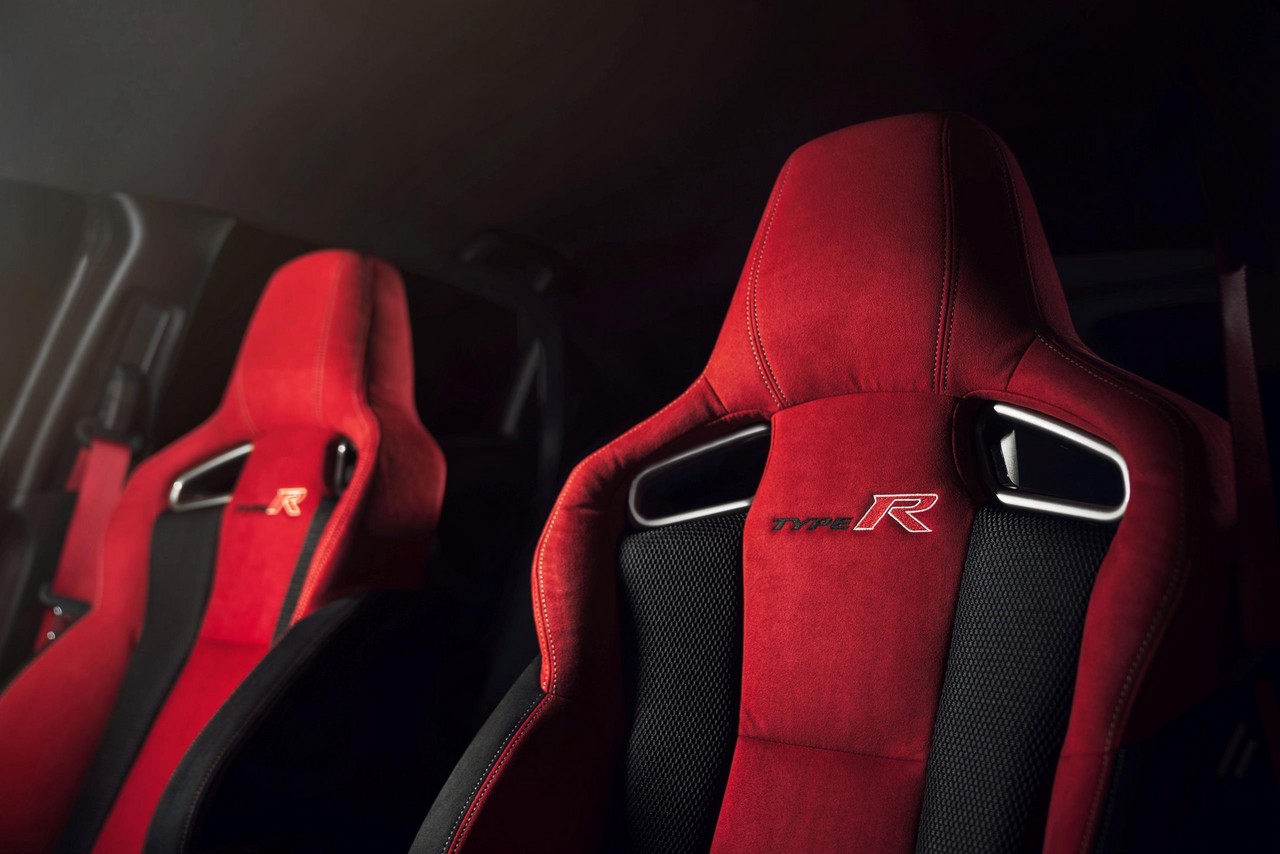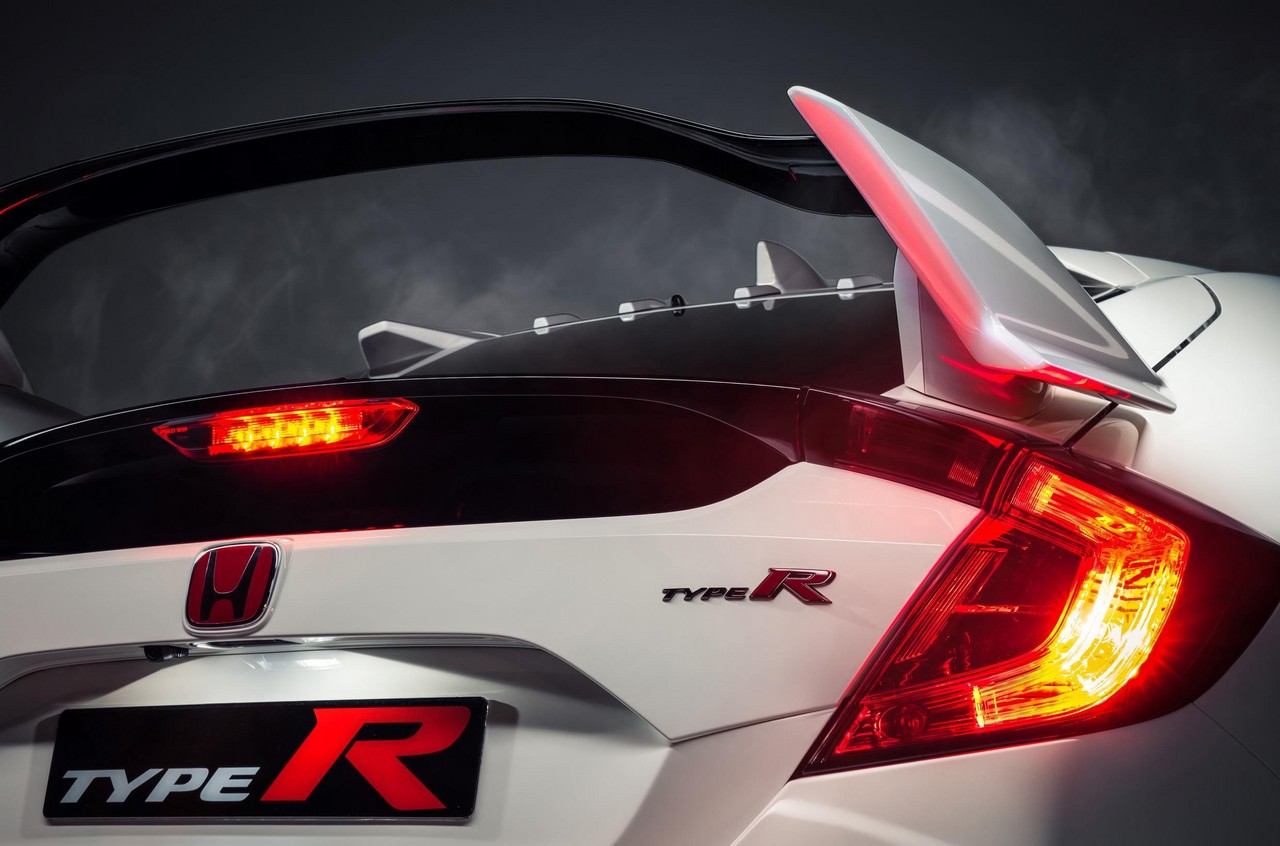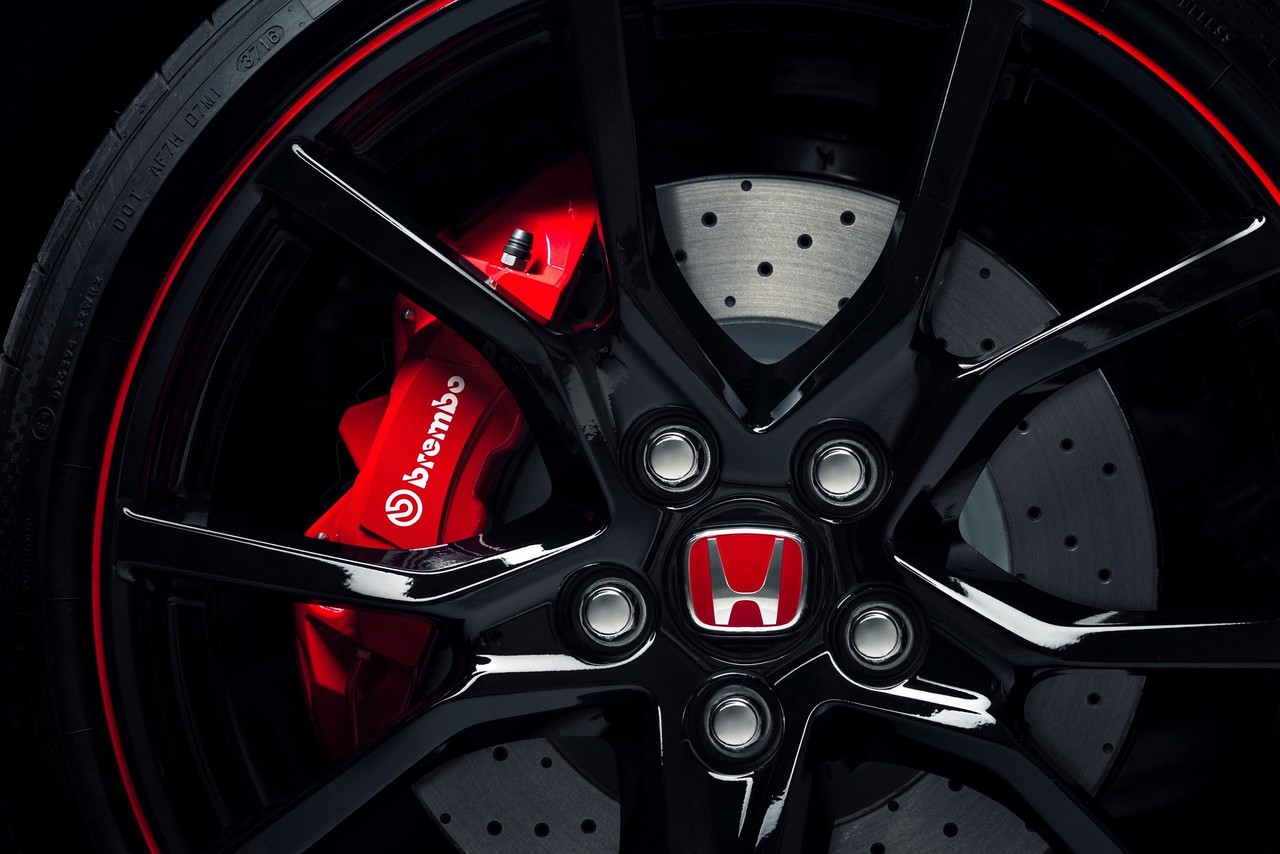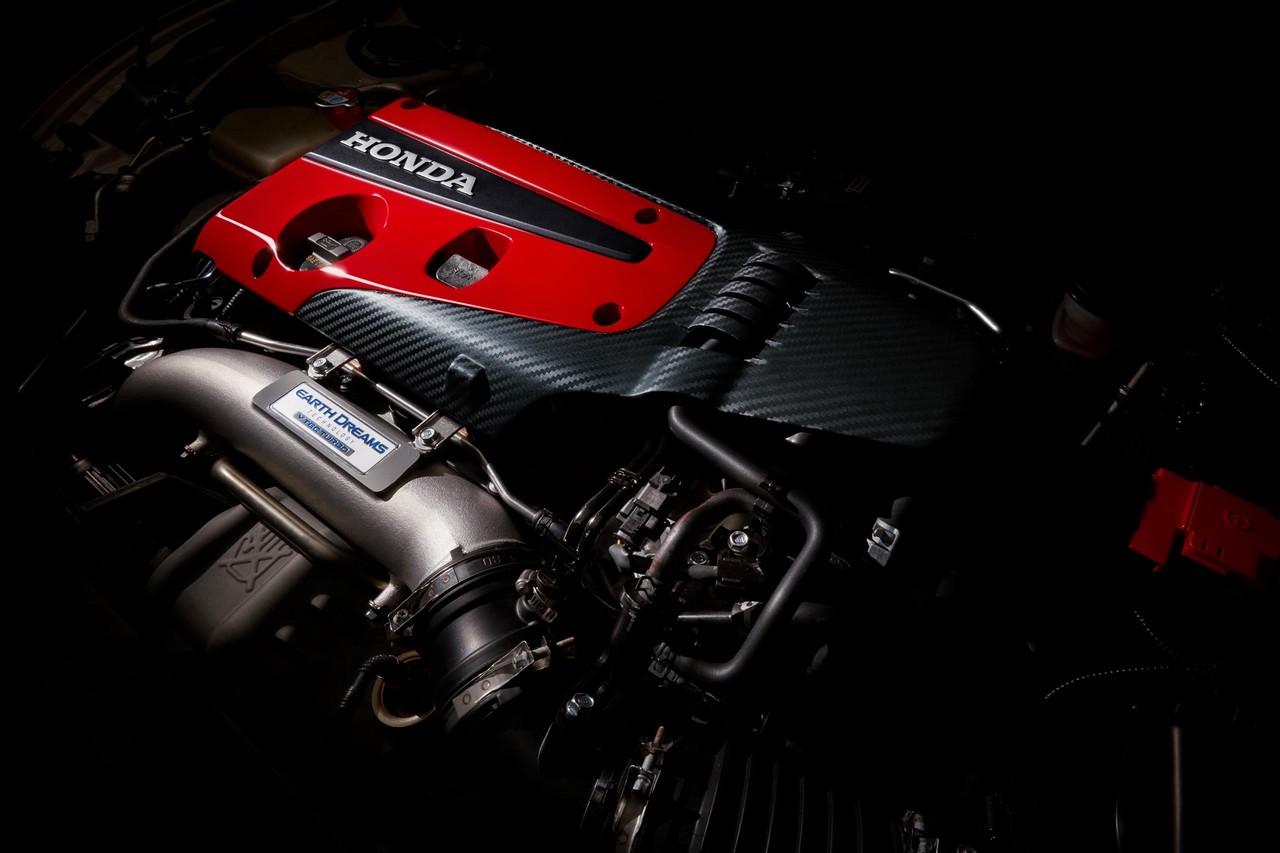
- Power, traction and stability make for extraordinary race track performance
- Supportive front bucket seats (for thigh and lower back support, at least)
- Steering is accurate and torque steer is well controlled
- Excellent brake feel
- Lag from single-scroll turbocharger means performance isn’t immediately accessible
- Body may provide downforce, but it’s hardly pretty
- No satellite navigation system
- Tyre roar on coarse surfaces
- Some examples have interior vibrations and rattles
- Misses out on the 452 watt sound system of the Honda FK4/FK5 Civic hatch
Overview
Released in Australia in September 2017, the Honda FK8 Civic Type R was a performance hatch. Manufactured in Swindon, UK, the Honda FK8 Civic Type R was powered by a 2.0-litre turbocharged petrol engine that was mated to a close-ratio six-speed manual transmission. Upon its Australian release, the Civic Type R had a manufacturer list price of $50,990 (excluded on-road costs such as stamp duty, registration, dealer deliver and, where required, CTP insurance).
The Honda FK8 Civic Type R was sold with a five year, unlimited kilometre warranty; if the vehicle was used for commercial purposes, however, the warranty was limited to five years or 140,000 kilometres, whichever came first.
Honda FK8 Civic Type R: K20C1 engine
The FK8 Civic Type R was powered Honda’s K20C1 petrol engine which had 86.0 mm bores and an 85.9 mm stroke for a capacity of 1996 cc. Beyond this, the K20C1 engine had an aluminium alloy block with centrifugally-cast iron cylinder liners, a forged steel crankshaft with micro-polished journals, heat-forged steel connecting rods that were then ‘crack separated’, cast aluminium pistons, a pressure-cast aluminium alloy cylinder head with exhaust ports cast into the head, hollow double overhead camshafts (chain-driven), four valves per cylinder (including sodium-filled exhaust valves for heat dissipation), direct injection via 20 MPa high-pressure injectors, a mono-scroll turbocharger which provided peak boost pressure of 1.57 bar (22.8 psi), an electronically controlled wastegate, an air-to-air intercooler, tumble intake ports, M12 spark plugs and a compression ratio of 9.8:1. Furthermore, the K20C1 engine had a 7000 rpm redline and required 95 RON premium unleaded petrol.
The K20C1 engine featured:
- Honda’s Dual-VTC (Variable Timing Control) which permitted a degree of valve timing overlap to improve responsiveness and efficiency; and,
- VTEC (Variable Timing and Lift Electronic Control) which varied exhaust valve lift to reduce turbo lag (by increasing exhaust pressure at lower rpm).
To minimise fuel consumption, an ‘Idling Stop’ function could shut down the engine when the Civic Type R was stationary in traffic.
The FK8 Civic Type R could accelerate from rest to 100 km/h in 5.7 seconds and had a top speed of 272 km/h. Over the combined ADR 81/02 test cycle, fuel consumption for the FK8 Civic Type R was 8.8 litres per 100 km.
| Engine | Trans. | Peak power | Peak torque | |
|---|---|---|---|---|
| FK8 Civic Type R | 1996 cc K20C1 turbo petrol I4 | 6sp man. | 235 kW at 6500 rpm | 400 Nm at 2500-4500 rpm |
Manual transmission
The Honda FK8 Civic Type R had a close-ratio, six-speed manual transmission which had a single-mass flywheel to reduce clutch inertia. To reduce shift shock, the manual transmission had a rev-matching function which automatically blipped the throttle on downshifts for smoother gearshifts. For cooling, the transmission had:
- A fin-shaped case that was matched to wind-directing shapes in the under-engine cover; and,
- A water-cooled oil cooler.
Body and dimensions
Compared to the Honda FK2 Civic Type R (which was not offered in Australia), the body of the FK8 Civic Type R was 16 kg lighter yet achieved a 38 per cent increase in torsional stiffness. Furthermore, aerodynamic measures for the FK8 Civic Type R included a smoother underbody, a front air curtain, a lightweight rear wing and ‘vortex generators’ at the trailing edge of the roof line. According to Honda, the body of the FK8 Civic Type R achieved ‘a best-in-class balance between lift and drag, contributing to greater high speed stability.’
Compared to the Honda FK4/FK5 Civic hatch on which it was based, the FK8 Civic Type R was 42 mm longer (at 4557 mm) and 78 mm wider (1877 mm), though height (1421 mm) and wheelbase length (2700 mm) were unchanged. Boot capacity for the FK8 Civic Type R was 414 litres.
To reduce mass, the FK8 Civic Type R had an aluminium bonnet which weighs 5.3 kg less than the steel bonnet of the FK4/FK5 Civic. The Honda FK8 Civic Type R had a tare mass of 1390 kg.
Suspension
The Honda FK8 Civic Type R had Macpherson strut front suspension and multi-link rear suspension. Compared to the Honda FK4/FK5 Civic , changes for the Civic Type R included:
- For the front suspension, a dual-axis design with aluminium lower arms and modified steering knuckles to reduce torque steer and improve at-the-limit cornering. Compared to the standard Honda FK4/FK5 Civic, initial camber was reduced by 1.0 degree and centre offset reduced by 19 mm;
- For the rear suspension, unique high rigidity suspension arms;
- Unique spring, damper and bushing settings; and,
- A four-wheel Adaptive Suspension System (ASS) with three-chamber dampers that were activated by electromagnetic coils inside the dampers to alter oil flow channels. The ASS provided continuous and independent control of each wheel to 1) limit wheel-load transfer during sharp acceleration and deceleration, and 2) improve ride comfort for normal driving. The ASS operated in response to feedback from three g-sensors: one of each side of the vehicle at the base of the A-pillars and one just forward of the rear axle. Furthermore, stroke sensors on the suspension of each wheel provided real-time monitoring.
The driver could select from three driving modes – Comfort, Sport and +R – which adjusted settings for the Adaptive Damper System, steering assistance, throttle response, transmission rev-matching and electronic stability control intervention thresholds. In +R mode, for example, damping forces increased by 15 per cent relative to Sport mode for a firmer, flatter ride.
Steering
The Honda FK8 Civic Type R had dual-pinion steering system with electric power assistance and a variable gear ratio. The steering wheel required 2.11 turns from lock-to-lock, while the FK8 Civic Type R had a turning circle of 12.56 metres.
Safety equipment
Standard safety equipment for the Honda Civic Type R included dual front airbags, front seat-mounted side airbags, full-length curtain airbags, ABS, electronic brake force distribution, brake assist, electronic stability control, traction control and front seatbelts with pre-tensioners and load limiters.
The Honda Civic Type R was also equipped with the following safety technologies –
- Forward Collision Warning (FCW) and Collision Mitigation Braking System (CMBS): operating at speeds above 15 km/h, FCW and CMBS used a millimetre-wave radar and a camera located in the windscreen to monitor the road up to 100 metres ahead. If FCW detected that there was a collision risk with the vehicle ahead, a ‘Brake’ warning would flash in the Multi-Information Display and an audible warning would sound. In its second stage, CMBS applied light braking to reduce vehicle speed and alert the driver. In its final stage when a collision was assessed to be inevitable, CMBS applied maximum braking force to reduce vehicle speed and the severity of the collision;
- Lane Keep Assist System (LKAS) with Road Departure Mitigation: used a camera to detect if the vehicle was departing from its lane without indicating and, if so, automatically applied corrective steering inputs (‘Road Departure Mitigation System’). Visual and audible warnings were also issued (‘Lane Departure Warning’, LDW);
- Intelligent Adaptive Cruise Control (IACC): operating at speeds above 30 km/h, IACC enabled the vehicle to maintain a specified distance from the vehicle ahead and could apply up to a quarter of the maximum braking force to slow the vehicle if it was approaching the vehicle ahead. For speeds below 40 km/h, a Low Speed Following function could be engaged to follow the vehicle ahead; and,
- Honda’s LaneWatch: used a camera positioned below the passenger-side door mirror to increase the view of the passenger-side mirror by up to 80 degrees, with the camera output visible on the multi-information display.
The ‘Agile Handling Assist’ (AHA) electronic stability system had ‘bespoke operating parameters’ for the track-focused ‘+R’ mode. Using the stability control system, AHA could apply light braking force to the inner wheels when the steering wheel was turned to generate yaw and reduce understeer.
ANCAP safety rating
In ANCAP crash testing , the Honda FC1/FC6 Civic sedan received a five star adult occupant protection rating with a score of 34.68 out of 37; since this rating was applied to the FK4/FK5 Civic hatch , it is expected that it will also be applied to the FK8 Civic Type R. In the frontal offset tests, protection of the front occupants’ heads and upper legs were rated as good, though chest and lower leg protection were rated as adequate (i.e. a slight risk of serious injury). In the side impact test, protection of the head, abdomen and pelvis were rated as good, though chest protection was rated as adequate.
Wheels, tyres and brakes
The Honda FK8 Civic Type R had 8.5J x 20-inch ‘Berlina’ aluminium alloy wheels with 245/30 ZR20 Continental SportContact6 tyres. Furthermore, the Civic Type R had 350 mm by 32 mm cross-drilled front brake discs with four-piston Brembo callipers and 305 mm by 11 mm solid rear discs.
Features: Honda FK8 Civic Type R
As standard, the Honda Civic Type R was equipped with Honda’s ‘Advanced Display Audio’ multimedia system which includes a seven-inch colour touch screen, a 160 watt sound system with four speakers and four tweeters, a digital radio tuner (DAB+), Android Auto and Apple CarPlay smartphone integration, Bluetooth mobile phone connectivity and audio streaming, two USB ports and HDMI connectivity.
Other standard features for the Honda Civic Type R included front bucket seats with red suede-style fabric, dual-zone climate control air conditioning, cruise control with speed limiters, auto-levelling LED headlights with dusk-sensing function, LED front fog lights and daytime running lights, front and rear parking sensors, a rear view camera with dynamic guidelines, 60:40 split fold rear seats, a leather-wrapped steering wheel and gearshift boot, remote central locking with proximity key, power adjustable and heated door mirrors, power windows, tilt and telescopic steering wheel adjustment, a height adjustable driver’s seat, an auto-dimming rear view mirror, push-button start, an electric parking brake, a 12 volt power socket in the front console, ‘carbon fibre effect’ interior trim, an aluminium shift knob, drilled alloy sports pedals, illuminated vanity mirrors, a cargo cover, tyre deflation warning system, trip computer, an alarm and immobiliser.
As standard, the Honda Civic Type R was fitted with a helical limited-slip front differential.
Paint colours
The Honda Civic Type R was available in five paint colours: Championship White, Rally Red, Crystal Black (pearlescent), Sonic Grey (pearlescent) and Brilliant Sporty Blue (metallic).
Specifications
Press Kit

